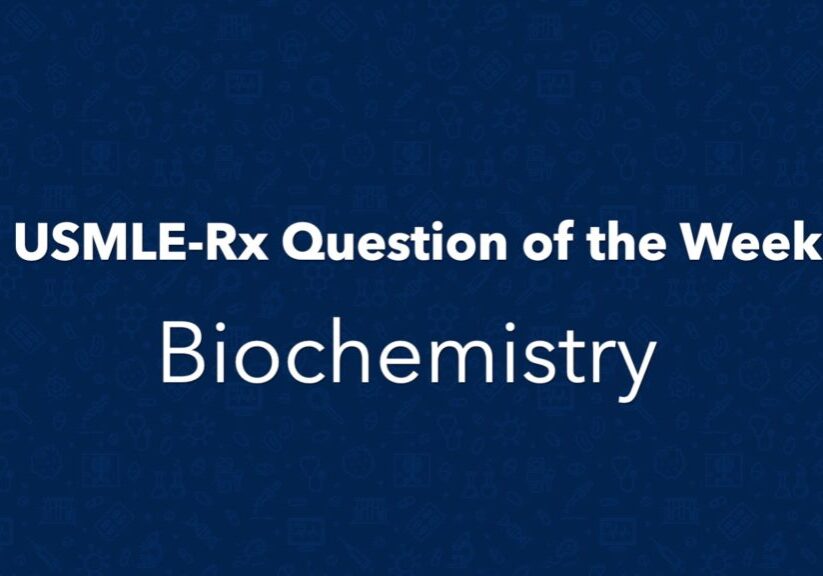Check out today’s Step 1 Qmax Question Challenge.
Know the answer? Post it below! Don’t forget to check back for an update with the correct answer and explanation (we’ll post it in the comments section below).
 A 69-year-old smoker presents with double vision, lower extremity muscle weakness that improves with exertion, and diminished deep tendon reflexes. Results of neurologic, cardiovascular, and ophthalmologic examinations are negative. An X-ray of the chest is shown. A full cancer work-up reveals metastases throughout the body.
A 69-year-old smoker presents with double vision, lower extremity muscle weakness that improves with exertion, and diminished deep tendon reflexes. Results of neurologic, cardiovascular, and ophthalmologic examinations are negative. An X-ray of the chest is shown. A full cancer work-up reveals metastases throughout the body.
Which of the following is the most likely cause for this man’s diplopia and weakness?
A. Antibodies against presynaptic calcium channels at the neuromuscular junction
B. Autoantibodies to acetylcholine receptors at the neuromuscular junction
C. Autoimmune disease with anti-double-stranded DNA, anti-DNA, and anti-Smith antibodies
D. Inflammatory disorder of synovial joints with pannus formation
E. Reactivation of a peripheral subpleural parenchymal lesion and hilar lymph nodes
———————–
Want to know the ‘bottom line?’ Purchase a USMLE-Rx Subscription and get many more features, more questions, and passages from First Aid, including images, references, and other facts relevant to this question.
This practice question is an actual question from the USMLE-Rx Step 1 test bank. For more USMLE Step 1 prep, subscribe to our Flash Facts and Step 1 Express video series. Score the best deal on all three products with USMLE-Rx 360 Step 1.




I do not see any answer choices to choose from. My guess is that lower extremity muscle weakness (that improves with exertion), diplopia, lung cancer (shown on X-ray), older pt who smokes is related to Lambert-Eaton syndrome.
Myasthenia
Shree,
Myasthenia weakness tends to worsen with muscle use. Lambert-Eaton myasthenic syndrome is usually associated with “proximal muscle weakness . . . improves with muscle use/[exertion]” (First Aid 2015, pg 435).
A. Antibodies against presynaptic calcium channels at the neuromuscular junction
B. Autoantibodies to acetylcholine receptors at the neuromuscular junction
C. Autoimmune disease with anti-double-stranded DNA, anti-DNA, and anti-Smith antibodies
D. Inflammatory disorder of synovial joints with pannus formation
E. Reactivation of a peripheral subpleural parenchymal lesion and hilar lymph nodes
The correct answer is A. This patient is 69 years old and presents with diplopia, weakness in his lower extremities that improves with exertion, and diminished deep tendon reflexes. He has a history of smoking, and a cancer work-up reveals metastasis throughout the patient’s body.
His X-ray shows a central lung cancer, which is likely the primary malignancy. His proximal muscle weakness, decreased deep tendon reflexes, and diplopia point toward a paraneoplastic syndrome.
B is not correct. Myasthenia gravis involves the production of autoantibodies to acetylcholine receptors at the neuromuscular junction and is occasionally seen with thymoma. Symptoms often include muscle weakness and diplopia. Muscle weakness worsens with use in MG, whereas this patient finds that muscle weakness improves with exertion.
C is not correct. Systemic lupus erythematosus is associated with multiple symptoms, including skin rash, hair loss, fever, and anorexia, which are not reported in this patient. The patient is a 66-year-old man, and this condition is usually seen in females 14–45 years old.
D is not correct. This describes rheumatoid arthritis (RA). RA manifests with symmetric morning stiffness, joint inflammation, and systemic symptoms (fever and fatigue), which are not seen in this patient. The disease is also seen mostly in females.
E is not correct. This describes secondary tuberculosis, which is uncommon except in immunocompromised patients. This patient has evidence of a primary tumor with metastases, making tuberculosis highly unlikely.
Will,
I know it is LEMS
LEMS is also associated with Myasthenia
Even I would have gone for A)
A. Lambert-Eaton (presynpactic) ; Myasthenia (postsynaptic)
A
Eaton-Lambert Syndrome
The tumor is surely a SCC of the lung
amazing
Wow that was strange. I just wrote an very long comment but after I clicked submit my comment didnt appear. Grrrr well Im not writing all that over again. Regardless, just wanted to say excellent blog!
Jason
Colt